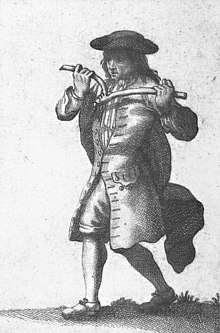
Back استنباء بالعصا Arabic Virgule Czech Kvistgang Danish Aplicación práctica de la radiestesia Spanish Kaivonkatsonta Finnish Sourcier French Spákvistur Icelandic ダウジング Japanese Wichelroedeloper Dutch Лозоходство Russian

Dowsing is a type of divination employed in attempts to locate ground water, buried metals or ores, gemstones, oil, claimed radiations (radiesthesia),[1] gravesites,[2] malign "earth vibrations"[3] and many other objects and materials without the use of a scientific apparatus. It is also known as divining (especially in water divining),[4] doodlebugging[5] (particularly in the United States, in searching for petroleum or treasure)[6] or water finding, or water witching (in the United States).
A Y-shaped twig or rod, or two L-shaped ones, called dowsing rods or divining rods are normally used, and the motion of these are said to reveal the location of the target material. The motion of such dowsing devices is generally attributed to random movement, or to the ideomotor phenomenon,[7][8][9] a psychological response where a subject makes motions unconsciously.
The scientific evidence shows that dowsing is no more effective than random chance.[10][11] It is therefore regarded as a pseudoscience.
- ^ As translated from one preface of the Kassel experiments, "roughly 10,000 active dowsers in Germany alone can generate a conservatively-estimated annual revenue of more than 100 million DM (US$50 million)". GWUP-Psi-Tests 2004: Keine Million Dollar für PSI-Fähigkeiten Archived April 10, 2005, at the Wayback Machine (in German) and English version Archived August 14, 2007, at the Wayback Machine.
- ^ Pellwel, Calvin E (May 19, 2022). "What Is Dowsing? - The Ancient Practice For Treasure Hunting". Archived from the original on March 26, 2023. Retrieved June 19, 2022.
- ^ "Bad vibrations: what's the evidence for geopathic stress?". the Guardian. 2015-08-20. Archived from the original on 2023-03-26. Retrieved 2022-11-18.
- ^ Cite error: The named reference
inglis245was invoked but never defined (see the help page). - ^ "Dowsing, Doodlebugging, and Water Witching". Association of Independent Readers and Rootworkers Wiki. Archived from the original on 12 October 2011. Retrieved 11 October 2011.
- ^ Lyman, Thomas G. (1967). "Water Dowsing as a Surviving Folk Tradition". Keystone Folklore Quarterly. 12: 137. Archived from the original on 2023-03-11. Retrieved 2022-06-25 – via HathiTrust.
- ^ Zusne, Leonard; Jones, Warren H. (1989). Anomalistic Psychology: A Study of Magical Thinking. Lawrence Erlbaum Associates, Inc. pp. 105–110. ISBN 978-0-805-80507-9
- ^ Novella, Steve; Deangelis, Perry. (2002). Dowsing. In Michael Shermer. The Skeptic Encyclopedia of Pseudoscience. ABC-CLIO. pp. 93–94. ISBN 1-57607-654-7 "Despite widespread belief, careful investigation has demonstrated that the technique of dowsing simply does not work. No researcher has been able to prove under controlled conditions that dowsing has any genuine divining power... A more likely explanation for the movement of a dowser's focus is the ideomotor effect, which entails involuntary and unconscious motor behavior."
- ^ Lawson, T. J; Crane, L. L. (2014). Dowsing Rods Designed to Sharpen Critical Thinking and Understanding of Ideomotor Action. Teaching of Psychology 41 (1): 52–56.
- ^ Vogt, Evon Z.; Ray Hyman (1979). Water Witching U.S.A. (2nd ed.). Chicago: Chicago University Press. ISBN 978-0-226-86297-2. via Hines, Terence (2003). Pseudoscience and the Paranormal (Second ed.). Amherst, New York: Prometheus Books. p. 420. ISBN 978-1-57392-979-0.
- ^ Regal, Brian. (2009). Pseudoscience: A Critical Encyclopedia. Greenwood Press. pp. 55–57. ISBN 978-0-313-35507-3